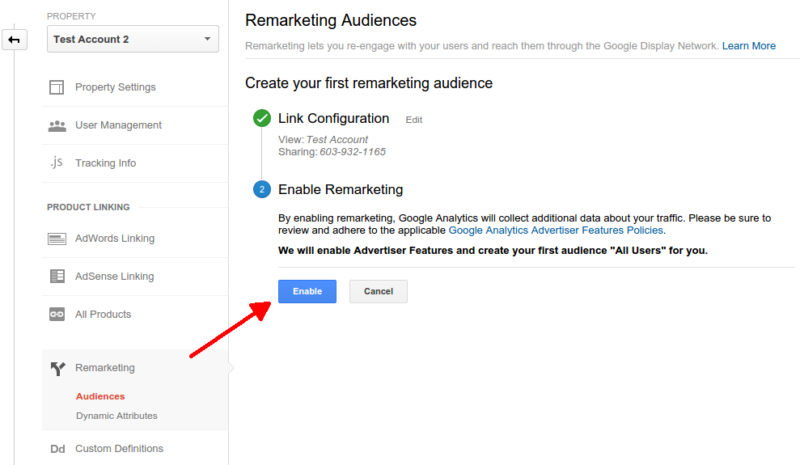Using Remarketing in Google Analytics: A Comprehensive Guide
Using remarketing in Google Analytics supplies services a critical side in connecting to prospective customers. The capability to target people that have actually currently connected with your internet site presents an one-of-a-kind chance for tailored advertising initiatives. By recognizing how to craft target market checklists and release them properly, businesses can substantially enhance their conversion prices. Nevertheless, the intricacies of establishing and maximizing remarketing campaigns require a detailed understanding of target market division and performance evaluation. This overview will clarify the important steps associated with using the full capacity of remarketing in Google Analytics, bring about enhanced marketing results.
Recognizing Remarketing in Google Analytics
Remarketing in Google Analytics enables organizations to strategically target individuals that have formerly engaged with their web site or mobile application. By leveraging data from Google Analytics, businesses can develop tailored remarketing lists based on individual actions, such as pages gone to, activities taken, or certain objectives attained. This effective device allows companies to re-engage with individuals who have actually revealed rate of interest in their solutions or products, inevitably boosting the probability of conversion.
Comprehending the different sorts of remarketing approaches is vital for an effective project - What Is “Remarketing” In Google Analytics?. Google Analytics supplies various options, including typical remarketing, dynamic remarketing, and remarketing lists for search ads (RLSA) Each kind offers a special objective and can be customized to satisfy certain marketing goals
Moreover, examining the performance of remarketing campaigns is crucial for optimizing results. Google Analytics supplies valuable understandings into the efficiency of various remarketing strategies, allowing organizations to make data-driven choices and fine-tune their targeting approach. By continuously changing and monitoring remarketing initiatives based upon analytics information, businesses can optimize ROI and drive success in their advertising efforts.
Setting Up Remarketing Projects

After establishing target market checklists, the next step is to connect Google Analytics with Google Advertisements. By connecting these two systems, companies can effortlessly move target market checklists from Google Analytics to Google Advertisements for remarketing objectives. This integration permits more accurate targeting and better project performance.
As soon as the accounts are linked, businesses can develop remarketing projects in Google Advertisements using the target market notes formerly defined in Google Analytics. These projects can be personalized with specific advertisement creatives, messaging, and bidding strategies to properly re-engage with previous site visitors and drive conversions. By following these actions, companies can utilize the power of remarketing to boost their marketing efforts and boost ROI.
Utilizing Target Market Segmentation Approaches

Predefined sectors in Google Analytics allow you to rapidly evaluate typical target market categories like brand-new customers, returning customers, or individuals who completed a details goal on your site. Custom-made sectors, on the other hand, allow you to create distinct sectors based upon details criteria that are essential to your company goals. Dynamic remarketing checklists automatically adjust based on user behavior, showing individualized advertisements to customers that have actually connected with your website specifically ways.
Studying Remarketing Performance Metrics
Upon evaluating the performance of remarketing projects in Google Analytics, the evaluation of essential performance metrics provides valuable insights into audience interaction and conversion rates. By diving into metrics such as click-through prices (CTR), conversion prices, price per purchase (CERTIFIED PUBLIC ACCOUNTANT), and return on advertisement invest (ROAS), marketers can evaluate the success of their remarketing initiatives. Examining these metrics allows online marketers to enhance campaigns, improve audience targeting, and allot spending plans successfully to enhance overall remarketing performance.
Enhancing Remarketing Approaches
When refining remarketing techniques in Google Analytics, concentrating on audience division is vital for accomplishing project success. By separating your audience right into certain sections based upon their behavior, demographics, or rate of interests, you can customize your ads a lot more properly per team. This targeted method enhances the chance of involving users that have already shown rate of interest in your services or products, leading to greater conversion prices.
An additional vital aspect of maximizing remarketing strategies is continually testing and refining your projects (What Is “Remarketing” In Google Analytics?). A/B testing different advertisement creatives, messaging, or offers can aid you identify what resonates finest with your target market and drives one of the most conversions. By evaluating the performance top article of these examinations in Google Analytics, you can make data-driven decisions to optimize your remarketing efforts even more
Furthermore, leveraging dynamic remarketing can significantly enhance your campaign results. This function allows you to reveal personalized ads to users based on their past read the article interactions with your web site, showcasing service or products they have previously checked out. By supplying customized web content to users based upon their behaviors and passions, vibrant remarketing can aid increase engagement and drive conversions.
Conclusion
Finally, taking advantage of remarketing in Google Analytics is a tactical method to target individuals who have previously involved with a site. By producing tailored audience checklists and making use of audience segmentation methods, organizations can optimize remarketing campaigns for raised conversion prices. Analyzing performance metrics and continually enhancing techniques are important for taking full advantage of the effectiveness of remarketing initiatives.
Google Analytics supplies numerous choices, consisting of basic remarketing, dynamic remarketing, and remarketing lists for search advertisements (RLSA)After setting up audience checklists, the next action is to connect Google Analytics with Google Advertisements. By linking these two systems, companies can seamlessly move audience checklists from Google Analytics to Google Advertisements for remarketing purposes.Once the accounts are linked, organizations can produce remarketing campaigns in Google Ads utilizing the target market notes previously specified in Google Analytics.When refining remarketing methods in Google Analytics, concentrating on audience division is vital for attaining campaign success.